#productowners
Explore tagged Tumblr posts
Text
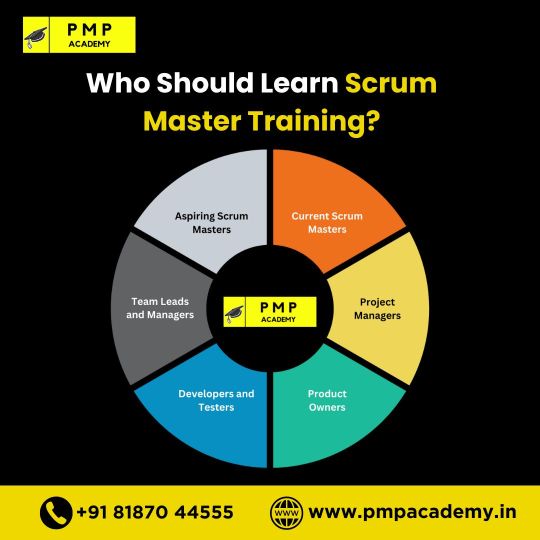
"🌟 Who Should Learn Scrum Master Training? 🌟
At PMP Academy, our Scrum Master Training is designed for everyone looking to excel in their careers and enhance their project management skills. Whether you're an aspiring Scrum Master, a seasoned professional, or in a different role, our training can benefit you.
👩💻 Aspiring Scrum Masters 👨🏫 Current Scrum Masters 👨💼 Project Managers 👩🔧 Developers and Testers 👩🔬 Product Owners 👥 Team Leads and Managers
Join us today and take the next step in your professional journey!
📞 Contact us at +91 81870 44555
#ScrumMaster#ProjectManagement#AgileTraining#ProfessionalDevelopment#Scrum#Agile#CareerGrowth#TeamLeads#ProductOwners#Developers#ProjectManagers"#scruminterview#scrum methodology#scrum
0 notes
Text
Ways to Add Details and Level of Details in User Story
Discover the ways to add details and levels of information to user stories for success in your agile project. Splitting the story and adding acceptance criteria can provide precise details. Share the right level of detail to complete an iteration without overwhelming the team.
#userstories#agiledevelopment#productowners#acceptancecriteria#splittinguserstories#teamcollaboration#agilemindset#successinagile#projectmanagement#iterationplanning#productbacklog#agile#success#project#team#scaledagileframework#blogpost
0 notes
Text
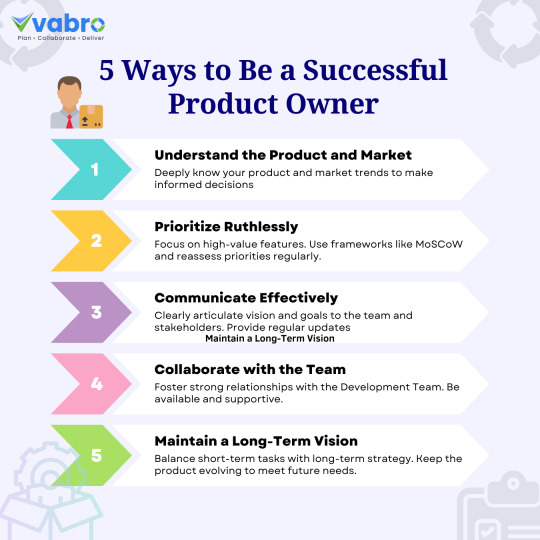
5 Ways to Be a Successful Product Owner
Being a successful Product Owner requires a strategic approach and effective collaboration. Here are five key strategies to excel in this role:
Understand the Product and Market: Deep knowledge of your product and market trends is essential. This understanding enables you to make informed decisions that align with user needs and business goals.
Prioritize Ruthlessly: Focus on high-value features that will deliver the most impact. Use prioritization frameworks like MoSCoW to regularly reassess and adjust priorities, ensuring resources are allocated effectively.
Communicate Effectively: Clear communication is crucial. Articulate your vision and goals to both the team and stakeholders, providing regular updates to keep everyone aligned and informed.
Collaborate with the Team: Build strong relationships with the Development Team. Be accessible and supportive, fostering an environment of trust and teamwork to drive project success.
Maintain a Long-Term Vision: Balance short-term tasks with a long-term strategy. Continuously evolve the product to meet future needs, ensuring it remains relevant and competitive in the market.
Implementing these strategies will help you lead your product to success, delivering value and achieving your business objectives.
🔗 Visit www.vabro.com to know more.
3 notes
·
View notes
Text
#projectmanagementautomation#projectmanagerautomation#PMO#ProjectManager#BusinessAnalyst#ProgrammeManager#Governance#ScrumMaster#Planning#ProductOwner#Gantt#POAP#Projecttemplates
2 notes
·
View notes
Text
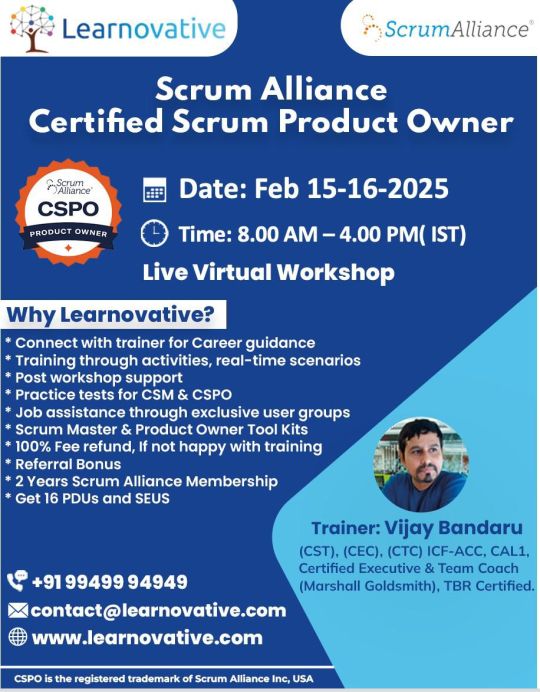
🚀 CSPO Certification | 15 – 16 Feb 2025 | Live Virtual Training | Learnovative 🚀
🔥 Master Agile Leadership with CSPO Certification! 🔥
📅 Date: 15 – 16 Feb 2025
⏰ Time: 8:00 AM – 4:00 PM IST
💻 Mode: Live Virtual Classroom (LVC)
🎯 Trainer: Vijay Bandaru
🔥 Take Your Agile Career to the Next Level! 🔥
✅ Master product vision, backlog management & stakeholder collaboration
✅ Gain expert insights from Vijay Bandaru
✅ Earn a globally recognized certification and boost your career
📢 Limited Seats Available! Secure Your Spot Today!
📞 Call now : 09949994949
#ScrumProductOwner#AgileLeadership#Learnovative#ScrumCertification#ProductOwner#AgileMindset#CareerGrowth#CSM#CSPO#ACSM#ACSPO#CSMtraininginHyderabad#CSMtrainingcoursesinHyderabad#ScrumMastertraininginHyderabad#ScrumMastercertificationinHyderabad#CertifiedScrumMastercertificationinHyderabad#CertifiedScrumMastercertificationtraininginHyderabad#CSMcertificationinHyderabad#CertifiedScrumTrainerinHyderabad#CertifiedAgileScrumTrainerinHyderabad#CertifiedEnterpriseCoachinHyderabad#CertifiedTeamCoachforCSMinHyderabad#CertifiedTeamCoach#CSPOinHyderabad
0 notes
Text
Advanced Certified Scrum Product Owner(A-CSPO) Training | Vijay Bandaru
🚀 Ready to elevate your Agile skills? Join the A-CSPO Training with the best trainer, Vijay Bandaru! 🌟 Gain insights, master strategies, and transform your projects! 💡✨
👨🏫 Learn from the expert and become an Agile Certified Scrum Product Owner! 📈💼 Don’t miss this opportunity to boost your career and make a difference in your team’s success. 🚀🙌
New weekend Batch Starting From 08-10 January 2025
Online & Classroom Training Available 📞 Call Us: +91 9848032144 ⏰ Timings: 06:30PM To 11:30PM 🌐 www.vijaybandaru.com/portfolio/
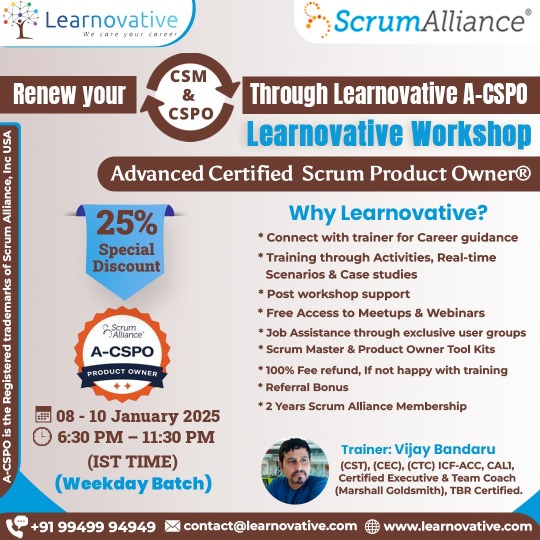
#AgileTraining#ScrumMaster#VijayBandaru#ProductOwner#A-CSPO#CSPO#ACSPO#CSM#ACSM#Vijaybandaru#AgileCoach#Certification#TrainingProgram#SkillDevelopment
0 notes
Text
🚀 Senior Product Owner in Hamburg verfügbar! 🚀
Moin, hi! Dieses Video geht an alle Arbeitgeber, Personalverantwortlichen und IT-Recruiter, die einen erfahrenen Senior Product Owner suchen. Wir stehen in Kontakt mit einem sehr sympathischen Kandidaten, der seit 2017 in der agilen Produktentwicklung tätig ist und umfangreiche Erfahrung im Produktmanagement und agilen Tooling mitbringt.
Details zum Profil:
Standort: Hamburg, bevorzugt hybrid (zeitweise vor Ort)
Sprachen: Deutsch (Muttersprache), Englisch (verhandlungssicher)
Gehaltsvorstellung: 85.000 - 90.000 Euro
Kündigungsfrist: 3 Monate zum Monatsende
Falls Sie Interesse an diesem Profil haben, melden Sie sich gerne bei uns, um die Details zu besprechen. Ich freue mich auf Ihre Nachrichten! [email protected]
0 notes
Text

#education#itcertificationcourseinchennai#itcertificatiom#scrummaster#scrummastercourse#agilescrummaster#professionalscrummaster#productowner#professtionalscrummaster
0 notes
Link
#quality.de#ScrumMaster ProductOwner ScrumTraining AgileMethoden ScrumFramework Schulung Weiterbildung ManagementTraining
0 notes
Text
CSPO Certification: Your Gateway to Becoming a Certified Scrum Product Owner
In the current dynamic and cutthroat business landscape, companies are always looking for methods to boost productivity, flexibility, and client happiness. Scrum and other agile approaches have become well-liked frameworks for achieving these objectives. The Product Owner, who is in charge of optimizing the value of the final product that the Development Team has worked on, plays a crucial part in Scrum. Many professionals seek the CSPO certification, also called the certified scrum product owner certification, in order to succeed in this capacity. This blog explores the value of CSPO certification, how to get it, and how it affects your career.
Understanding CSPO Certification
The acronym CSPO, which stands for Certified Scrum Product Owner, is awarded by the Scrum Alliance, a prominent body within the Agile community. The goal of the cspo certification is to give candidates the know-how and abilities needed to connect with stakeholders, manage the product backlog, and make sure the team produces value-driven products.
A Product Owner: What Is She?
Gaining insight about the function of a Product Owner in a Scrum team is crucial before delving into the specifics of certification. One of the most important stakeholders is the Product Owner, who is in charge of specifying the characteristics of the product and making sure the Development Team concentrates on the most important tasks. Among their duties are:
Product Backlog Management: Setting the product backlog in order of importance so that the team is constantly working on the most valuable activities.
Serving as a liaison between the development team and stakeholders to guarantee that the product satisfies both stakeholder expectations and market demands is known as stakeholder communication.
Establishing a clear vision for the product is essential to pointing the team in the right direction.
Why Should I Get Certified as a CSPO?
Enhanced Knowledge and Skills: With a particular emphasis on the duties of the Product Owner, the CSPO certification program offers a thorough grasp of Scrum methods and principles.
Job Advancement: Having a CSPO certification can greatly improve your job chances and open doors to new opportunities, as Agile and Scrum techniques are increasingly being adopted across a variety of industries.
Improved Scrum Team cooperation: You can promote improved Scrum team cooperation and more productive and efficient product development by having a thorough understanding of the role of the Product Owner.
Enhanced Credibility: Having earned your Scrum Product Owner certification shows that you are knowledgeable about the industry and dedicated to your work, which can set you apart in the employment market.
The Path to Becoming a Certified Scrum Product Owner
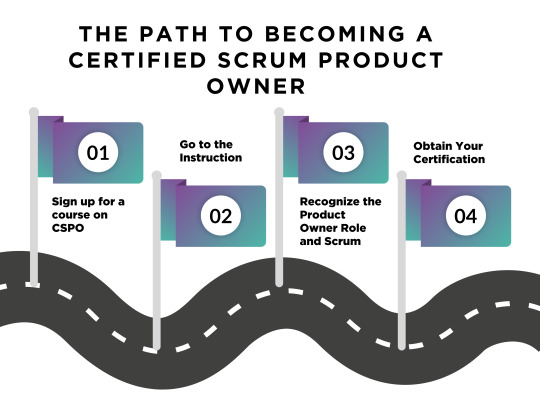
There are a few essential steps in becoming certified as a CSPO. This comprehensive information will assist you in comprehending the procedure:
Step 1: Sign up for a course on CSPO
In order to become certified as a CSPO, you must first participate in an authorized CSPO course. These courses provide a comprehensive overview of Scrum and the Product Owner position, and they are usually taught by certified Scrum trainers (CSTs). Typically lasting two days, the training covers subjects like:
Fundamentals and tenets of Scrum
The duties and obligations of a Product Owner
Creating and prioritizing user stories in an efficient manner
Communication and Stakeholder Management
Step 2: Go to the Instruction
It is imperative that you attend the training since it gives you the practical information and hands-on experience that a Product Owner needs. You will take part in group discussions, interactive activities, and practical simulations throughout the course to help solidify the topics being taught.
Step 3: Recognize the Product Owner Role and Scrum
Although there isn't an exam for the CSPO course, it's still important to fully comprehend the content. Your future professional accomplishments as well as your function as a Product Owner will benefit from this information. Don't forget to go over the course materials again, interact with other participants, and ask your trainer any questions you may have.
Step 4: Obtain Your Certification
The Scrum Alliance will award you with your CSPO certification if you pass the course. The validity of this certification is for two years, after which you must renew it by accumulating Scrum Education Units (SEUs) via ongoing education and involvement in Scrum-related activities.
The Advantages of CSPO Certification
Numerous job prospects in a variety of industries are made possible with the CSPO certification. Product Owners with experience are in more demand as businesses adopt Agile approaches. With a CSPO certification, you can pursue the following career paths:
Product Owner: In charge of overseeing the creation of high-value products and managing the process of product development.
Product Manager: Managing the whole lifecycle of a product, from conception to launch and beyond.
Scrum Master: Encouraging the team to follow Scrum methods and making sure Scrum values are followed.
Agile Coach: Helping businesses implement Agile methods and streamline their product development procedures.
Higher Prospect for Earnings
When comparing Certified Scrum Product Owners to their non-certified counterparts, the former frequently have greater earning potential. Because of their particular knowledge and skills, individuals who hold the CSPO certification typically earn much more, according to numerous wage studies.
Enhanced Interactions Within Teams
Gaining a thorough grasp of the Product Owner position can help you improve teamwork in your Scrum group. Better team chemistry, increased output, and eventually the successful delivery of goods that meet or surpass client expectations result from this.
Individual Development and Progress
Achieving the status of Certified Scrum Product Owner requires not only professional but also personal development. Your life will benefit from the abilities you gain, such as strategic thinking, stakeholder management, and effective communication.
How to Keep Your CSPO Certification Current
Scrum Education Units (SEUs), which are necessary to retain the CSPO certification, are valid for two years. SEUs can be obtained by a number of actions, including:
Attending Scrum conferences and events: To stay current on the newest trends and best practices, take part in Scrum conferences, webinars, and get-togethers.
Constant learning: Read books, undertake independent research, and enroll in more Scrum and Agile-related courses.
Participation in the community: Share your expertise, write articles, or join discussion boards to give back to the Scrum community.
By renewing your CSPO certification, you can make sure that your knowledge of industry advancements and your ability to lead product teams are up to date.
In summary
For those who want to succeed as Product Owners in Scrum teams, the Certified Scrum Product Owner (CSPO) certification is an important qualification. It gives you the abilities and information required to interact with stakeholders, oversee the delivery of high-value goods, and manage product development processes. By promoting successful and efficient product development, earning the CSPO certification will benefit your organization's performance in addition to your own professional possibilities.
Being a certified Scrum Product Owner distinguishes you as a qualified and competent individual prepared to take on the difficulties of contemporary product development in a world where Agile approaches are increasingly the standard. With Agile and Scrum always changing, the CSPO certification is your ticket to success whether you're just starting out or looking to take your career to the next level.
#CSPO#CSPOCertification#CertifiedScrumProductOwner#Scrum#ScrumAlliance#ProductOwner#Agile#AgileMethodology
0 notes
Text
🔗 Visit www.vabro.com to know more.
3 notes
·
View notes
Text
Writing effective user stories is both an art and a science. By focusing on the user’s needs, keeping stories simple and small, and involving the whole team, you can create user stories that are actionable and aligned with your project’s goals. Remember, user stories are not just about delivering features; they’re about delivering value to the user. With well-crafted user stories, your Agile team will be better equipped to deliver high-quality software that truly meets user needs.
#UserStories#AgileDevelopment#ProductManagement#AgileTips#ScrumMaster#SoftwareDevelopment#AgileTeam#ProductOwner#StoryWriting#ProjectManagement
0 notes
Text
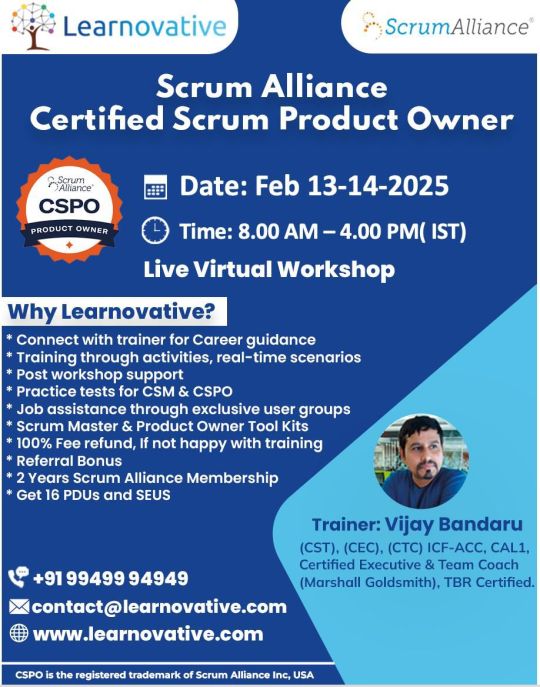
🚀 CSPO Certification | 13 – 14 Feb 2025 | Live Virtual Training | Learnovative 🚀
🔥 Master Agile Leadership with CSPO Certification! 🔥
🚀 Certified Scrum Product Owner (CSPO) – Live Virtual Training 🚀
📅 Date: 13 – 14 Feb 2025
⏰ Time: 8:00 AM – 4:00 PM IST
💻 Mode: Live Virtual Classroom (LVC)
🎯 Trainer: Vijay Bandaru
🎯 Why You Can’t Miss This!
✅ Become a certified leader in Agile & Scrum
✅ Master product vision, backlog management & stakeholder collaboration
✅ Gain insights from top industry expert, Vijay Bandaru
✅ Boost your career with a globally recognized certification
📢 Seats filling fast! Enroll now and take charge of your Agile journey!
📞 Call now : 09949994949
#ScrumProductOwner#AgileLeadership#Learnovative#ScrumCertification#ProductOwner#AgileMindset#CareerGrowth#CSM#CSPO#ACSM#ACSPO#CSMtraininginHyderabad#CSMtrainingcoursesinHyderabad#ScrumMastertraininginHyderabad#ScrumMastercertificationinHyderabad#CertifiedScrumMastercertificationinHyderabad#CertifiedScrumMastercertificationtraininginHyderabad#CSMcertificationinHyderabad#CertifiedScrumTrainerinHyderabad#CertifiedAgileScrumTrainerinHyderabad#CertifiedEnterpriseCoachinHyderabad#CertifiedTeamCoachforCSMinHyderabad#CertifiedTeamCoach#CSPOinHyderabad
0 notes
Text
Advanced Certified Scrum Product Owner(A-CSPO) Training | Vijay Bandaru
🚀 Ready to elevate your Agile skills? Join the A-CSPO Training with the best trainer, Vijay Bandaru! 🌟 Gain insights, master strategies, and transform your projects! 💡✨
👨🏫 Learn from the expert and become an Agile Certified Scrum Product Owner! 📈💼 Don’t miss this opportunity to boost your career and make a difference in your team’s success. 🚀🙌
New weekend Batch Starting From 21-22 Sep 2024
Online & Classroom Training Available 📞 Call Us: +91 9848032144 ⏰ Timings: 09:00am To 05:00pm 🌐 https://vijaybandaru.com/portfolio/

#AgileTraining#ScrumMaster#VijayBandaru#ProductOwner#A-CSPO#CSPO#ACSPO#CSM#ACSM#Vijaybandaru#AgileCoach#Certification#TrainingProgram#SkillDevelopment
0 notes
Text
Neuer Blog-Artikel von uns - Alles zum Beruf des Product Owners - von Aufgaben, wichtigsten Fähigkeiten bis aktuelle Gehälter
0 notes
Text
Mastering Sprint Management: A Comprehensive Guide
Sprint management is the heart of Scrum methodology, an Agile framework that facilitates efficient and collaborative project development. Sprints are short, time-boxed iterations that allow teams to deliver incremental value and adapt quickly to changes. Effective sprint management ensures that teams stay focused, productive, and aligned with project goals. This article explores the key aspects of sprint management, providing practical tips and best practices to optimize your sprints.
Understanding Sprints in Scrum
A sprint typically lasts between one to four weeks and begins with a sprint planning meeting. During this meeting, the Scrum team, which includes the Scrum Master, Product Owner, and Development Team, selects the backlog items (user stories) they aim to complete during the sprint. The goal is to create a potentially shippable product increment by the end of the sprint.
Key Roles in Sprint Management
Scrum Master: Facilitates the Scrum process, ensures adherence to Agile principles, and removes any impediments that might obstruct the team’s progress.
Product Owner: Represents the stakeholders and customers, prioritizes the backlog, and ensures that the team is working on the most valuable items.
Development Team: Self-organizing professionals who deliver the product increment. They estimate and commit to the work during the sprint planning
The Sprint Cycle
Sprint Planning
The sprint planning meeting sets the stage for the sprint. This meeting is divided into two parts:
What can be done?: The team reviews the product backlog and selects the items to be worked on. The Product Owner clarifies any doubts about the user stories.
How will it be done?: The team discusses how to implement the selected backlog items and breaks them down into tasks.
Key tips for effective sprint planning:
Set a clear sprint goal: Define a goal that provides focus and cohesion.
Prioritize backlog items: Ensure that the highest-priority items are selected.
Estimate accurately: Use estimation techniques like Planning Poker to gauge the effort required for each task.
Daily Scrum
The Daily Scrum (or stand-up) is a short, time-boxed meeting (15 minutes) where team members discuss:
What they did yesterday.
What they plan to do today.
Any impediments they are facing.
Effective daily scrums:
Stay focused: Stick to the three questions to keep the meeting brief.
Encourage accountability: Each team member should be prepared to share their progress.
Address impediments promptly: The Scrum Master should resolve any issues raised.
Sprint Review
The sprint review is held at the end of the sprint to inspect the increment and adapt the product backlog if needed. During this meeting, the team demonstrates the work completed to stakeholders.
Key aspects of a successful sprint review:
Showcase the increment: Demonstrate what has been accomplished.
Gather feedback: Engage stakeholders and collect their feedback.
Update the backlog: Adjust the backlog based on feedback and new insights.
Sprint Retrospective
The sprint retrospective follows the sprint review and focuses on continuous improvement. The team reflects on the sprint and discusses what went well, what didn’t, and how to improve in the next sprint.
Tips for a productive retrospective:
Create a safe environment: Encourage open and honest discussions.
Focus on actionable items: Identify specific actions to improve.
Celebrate successes: Acknowledge achievements and progress.
Tools for Sprint Management
Best Practices for Effective Sprint Management
Maintain a Healthy Backlog: Ensure your backlog is well-groomed and prioritized. Regularly update it to reflect changes and new priorities.
Ensure Clear Communication: Foster open communication within the team and with stakeholders. Use collaboration tools to keep everyone aligned.
Focus on Delivering Value: Prioritize work that delivers the most value to the customer. Avoid getting bogged down with low-impact tasks.
Adapt and Improve: Use retrospectives to drive continuous improvement. Be open to change and willing to adapt processes as needed.
Limit Work in Progress: Avoid overcommitting. Focus on completing a few tasks at a time to ensure high-quality deliverables.
Monitor Progress: Use burndown charts and other metrics to track progress and identify potential bottlenecks early.
Overcoming Common Challenges
Scope Creep: Clearly define the sprint goal and stick to it. Avoid adding new tasks mid-sprint unless they are critical.
Communication Breakdowns: Hold regular meetings and ensure all team members are on the same page. Use collaboration tools to facilitate communication.
Unrealistic Estimations: Use historical data and team experience to improve estimation accuracy. Encourage the team to be honest about what they can achieve.
Lack of Stakeholder Involvement: Involve stakeholders early and often. Use sprint reviews to keep them informed and engaged.
Conclusion
Effective sprint management is essential for successful Agile project delivery. By understanding the roles, adhering to the sprint cycle, using the right tools, and following best practices, teams can improve their efficiency and deliver high-quality products. Remember, the key to mastering sprint management lies in continuous improvement and adaptability. Keep refining your processes, and you'll see significant gains in productivity and team satisfaction.
By focusing on these elements, your Scrum team can better navigate the complexities of sprint management and consistently deliver value to your customers.
#sprintplanning#agile#scrum#projectmanagement#agiledevelopment#scrummaster#productowner#devteam#sprintgoals#backloggrooming#agilecoach
0 notes